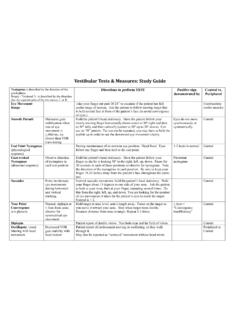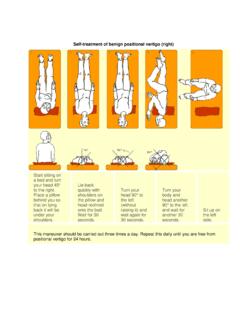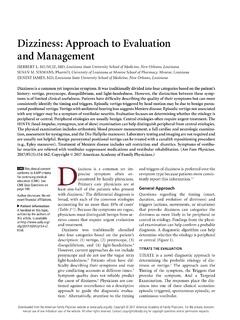Transcription of LET’S TALK ABOUT . . . Cawthorne-Cooksey Exercises
1 LET S TALK ABOUT .. Cawthorne-Cooksey Exercises SUPPORTING, INSPIRING AND EDUCATING THOSE AFFECTED BY BALANCE AND dizziness DISORDERS Updated June 2018 This is one in a series of BC Balance & dizziness information sheets written and reviewed by vestibular and other specialists. CONTACT OUR SOCIETY: Website: Facebook: Voicemail: 604-878-8383 or 1-866-780-2233 (toll-free) Email: If your vestibular system (inner ear balance system) is not working properly, you will feel dizzy and off balance. The purpose of this graduated set of simple Exercises is to reduce dizziness and restore your ability to balance. They work by gradually training your brain to tolerate the faulty information coming from the damaged inner ear balance sensors. The Exercises most done first with eyes open and, when dizziness improves, with eyes closed help re-program the brain to tune out the defective signals from the inner ear and compensate by also relying on information received from the eyes (vision) as well as muscles and joints (proprioception).
2 The Exercises were originally developed to help compensate a stable vestibular loss in one ear (unilateral) such as following acoustic neuroma surgery, vestibular neuritis, labyrinthitis or advanced stage (burn-out) M ni re's disease. They are also helpful for the dizziness that follows concussion and BPPV (benign paroxysmal positional vertigo). They will not help patients with spells of acute, active, recurrent, spontaneous vertigo (spinning sensation) for example, acute vestibular migraine or M ni re's disease because the brain cannot adjust to the fluctuating nature of these disorders. Do one group of Exercises at a time, starting with the first set. You might get dizzy when you first start. In the beginning, do one exercise until you provoke moderate symptoms (4 to 6 on a scale of 10), then stop, settle down and proceed to the next exercise . Practice the set in this manner 3 to 5 times a day. Diligence and perseverance are required despite any discomfort and passing dizziness brought on by the Exercises this dizziness should go away no more than 20 minutes after you stop an exercise .
3 If an exercise provokes severe symptoms right away, it is too hard and should be reserved for later in the process. Exercises that do not provoke symptoms can be skipped. The earlier and more regularly the exercise regimen is carried out, the faster and more complete will be your return to normal activity. Diligent practice of the Exercises should bring some improvements in ABOUT 6 to 8 weeks. If you have no improvement, seek professional advice. You may have a condition that is not a good candidate for these Exercises or you may need different types of Exercises . It is important to: Check with your doctor or vestibular physiotherapist before starting. Stop immediately and seek medical attention if any of the Exercises seem to cause any of the following symptoms: sharp, severe or prolonged pain in your neck, head or ear; a feeling of fullness in the ear; deafness or noises in the ear; fainting with loss of consciousness or blacking out; double vision, numbness, weakness or tingling in your arms and legs.
4 Stay safe have someone, or at least a sturdy handhold, within arm s reach, especially when doing the standing Exercises . Relax during all of the Exercises . Exercises are on the following page. Print them to use as a quick reference sheet when doing the Exercises . Cawthorne-Cooksey Exercises BC Balance & dizziness Website: Facebook: Voicemail: 604-878-8383 or 1-866-780-2233 (toll-free) Email: Updated June 2018 exercise 1 in bed or sitting and holding your head still Eye movements at first slow, then quick. Up and down as far as possible. Side to side as far as possible. Stretch one arm out straight; hold thumb up and focus on it. While continuing to focus on thumb, bring it in until ABOUT 30cm (12 ) from nose. exercise 2 in bed or sitting Head movements at first slow, then quick. Do first with eyes open and then, when dizziness improves, with eyes closed.
5 Bend head back as far as possible, then forward to touch chin to chest. Turn head from side to side as far as possible. exercise 3 sitting Eye and head movements as before. Shoulder movements o Shrug shoulders up and down. o Circle shoulders forwards and backwards. o Bend straight forward and pretend to pick something up from the floor. Then return to sitting position. exercise 4 standing Eye, head and shoulder movements as before. Sit down and stand back up. Do first with eyes open and then, when dizziness improves, with eyes closed. Throw a small ball from hand to hand (throw the ball above eye level so you must look up). Pass a small ball from hand to hand behind your knee (bend forward at the waist, legs slightly apart and one foot slightly forward). From a sitting position, stand up and turn in a complete circle, then sit back down. Alternate the direction turned. Stand in place when you turn around. exercise 5 moving ABOUT (in class or with a partner).
6 Do these in an open area free of obstacles. Circle around centre person who will throw a large ball and to whom it will be returned. Walk across room first with eyes open, when dizziness improves with eyes closed. Walk up and down slope first with eyes open, when dizziness improves with eyes closed. Any game involving stooping and stretching and aiming such as bowling, tennis, golf, table tennis and basketball.




